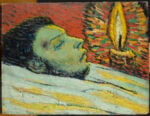Henrik Olai Kaarstein – Turning and Returning

I lavori sono frutto di un processo molto importante. Le scelte vengono fatte subito dopo aver raccolto i materiali e le superfici. Tutto viene mescolato e lasciato asciugare e rilavorato per alcuni giorni. I lavori realizzati con le strutture di letti ruotano attorno all’idea delle stampe di interni e dei packaging di cartone che presentano gli oggetti come in una dimensione che è al tempo stesso da sogno ma anche molto diretta.
Comunicato stampa
English version below
Nel 2010 Henrik Olai Kaarstein ha trascorso l’estate sistemando le abitazioni di due persone decedute e riponendo i loro oggetti in grandi contenitori disposti lungo i vialetti privati. Un lavoro orribile reso sopportabile dalla bellezza degli oggetti scoperti nelle case. Ciò che attirava di più la sua attenzione erano i tessuti, gli asciugamani, i lenzuoli, i tappeti e le tovaglie di colore pastello sbiadito e con stampe a fiori. Alcune erano trapunte tradizionali Norvegesi della fine del 1800, o del periodo del dopo guerra e altre d’IKEA dei giorni nostri.
Dopo l’estate, Kaarstein cominciò a mettere insieme la sua collezione di tessuti, spinto dalla curiosità di poter esplorare l’idea di quegli asciugamani o lenzuoli definiti “freschi” che vengono dati negli alberghi: il suo scopo era di sottrarre questi tessuti alla loro funzione per il corpo e al loro uso costante. Invece di farli diventare ‘nuovi’ un’altra volta, li congelava, li incollava e li mostrava ad un pubblico che li osservava in quanto oggetti estetici.
La maggior parte dei tessuti che costituiscono i lavori in mostra sono trovati/rubati/presi in prestito (in hotel, bar, saune, da amici, o nella spazzatura). Insieme a questi tessuti ci sono piccole tracce di oggetti di vita quotidiana, saponi di hotel e pantofole in particolare, tutti collezionati durante nottate decadenti trascorse in hotel di lusso; hotel raccomandati da riviste yuppie (rigorosamente maschili) dove l’artista si recava per assorbire l’atmosfera, fingendo di esserne parte, travestendosi e comportandosi in maniera eccessivamente educata e loquace con lo staff. (‘Una ricerca artistica molto costosa’).
I lavori sono frutto di un processo molto importante. Le scelte vengono fatte subito dopo aver raccolto i materiali e le superfici. Tutto viene mescolato e lasciato asciugare e rilavorato per alcuni giorni. I lavori realizzati con le strutture di letti ruotano attorno all’idea delle stampe di interni e dei packaging di cartone che presentano gli oggetti come in una dimensione che è al tempo stesso da sogno ma anche molto diretta.
Henrik Olai Kaarstein è nato a Oslo nel 1989, attualmente studia presso la Staatliche Hochschule für Bildende Künste Städelschule di Francoforte. ‘Turning and Returning’ è la sua prima mostra presso T293.
In 2010 Henrik Olai Kaarstein spent the summer cleaning two different dead women’s houses, putting stuff in huge containers parked in the driveway. The dreadful work was made bearable for him by virtue of the beautiful objects he discovered in each home. He was mostly drawn to the fabrics, towels, bed sheets, carpets and tablecloths in bleached pastel colors and flower prints. Some were traditional Norwegian quilts from the late 1800s, some post-war mail order and other modern day IKEA.
After the summer, Kaarstein started on his own textile collection, pushed by the curiosity of exploring the idea of a “fresh” towel or sheet presented at hotels: his aim was to remove the fabrics from their bodily function and the continuation in their use. Instead of becoming new again, they were frozen with glue and doomed to perform for the viewer as an aesthetic object.
Most of the fabrics that constitute the works exhibited are found/stolen/borrowed (from hotels, bars, saunas, friends, or garbage). Together with these fabrics are small traces of “business lifestyle” objects, hotel soaps and slippers in particular, all gathered from nights at high class hotels; hotels recommended by (straight male) yuppie magazines where the artist went to soak up the atmosphere, pretending to be a part of it, dressing up and being overly polite and talkative with the staff (‘A very expensive artistic research’).
The construction process is very important to the work. After he has collected the material and surface, choices are made quickly with a precise hand. Everything is mixed together and then left to dry and develop for days. The bed frame pieces work around both woodcut prints of interiors and cardboard packaging from home supplies, where the object’s use and look is photographed and illustrated in a dreamlike, but very direct manner.
Henrik Olai Kaarstein was born in Oslo in 1989, he is currently studying at Staatliche Hochschule für Bildende Künste Städelschule, Frankfurt. ‘Turning and Returning’ is his first show at T293.



